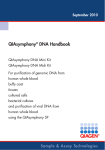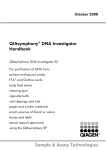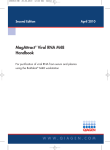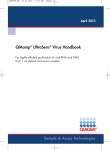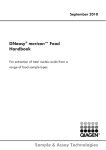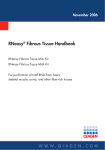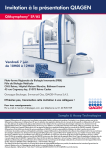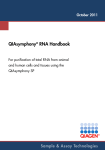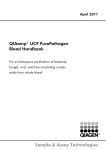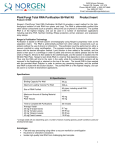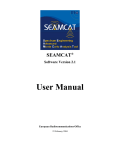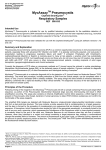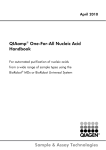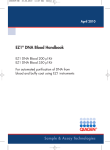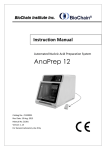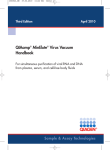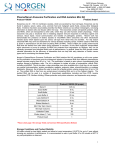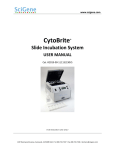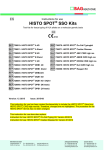Download Sample & Assay Technologies QIAsymphony® Virus/Bacteria
Transcript
March 2011 QIAsymphony® Virus/Bacteria Handbook QIAsymphony Virus/Bacteria Mini Kit QIAsymphony Virus/Bacteria Midi Kit For simultaneous purification of viral DNA and RNA from serum, plasma, or cerebrospinal fluid (CSF) and viral DNA, viral RNA, and bacterial DNA from respiratory and urogenital samples using the QIAsymphony SP Sample & Assay Technologies QIAGEN Sample and Assay Technologies QIAGEN is the leading provider of innovative sample and assay technologies, enabling the isolation and detection of contents of any biological sample. Our advanced, high-quality products and services ensure success from sample to result. QIAGEN sets standards in: Purification of DNA, RNA, and proteins Nucleic acid and protein assays microRNA research and RNAi Automation of sample and assay technologies Our mission is to enable you to achieve outstanding success and breakthroughs. For more information, visit www.qiagen.com. Contents Intended Use 4 Summary and Explanation 4 Principles of the Procedure 4 Materials Provided 7 Kit contents 7 Materials Required but Not Provided 8 Warnings and Precautions 9 Reagent Storage and Handling 11 Specimen Handling and Storage 11 Procedure 12 Automated purification on the QIAsymphony SP 12 Protocol General Purification Protocol 18 Troubleshooting Guide 22 Quality Control 25 Limitations 25 References 25 Contact Information 26 Ordering Information 27 QIAsymphony Virus/Bacteria Handbook 03/2011 3 Intended Use QIAsymphony Virus/Bacteria Kits are intended to be used only in combination with the QIAsymphony SP. Summary and Explanation QIAsymphony Virus/Bacteria Kits provide reagents for fully automated and simultaneous purification of viral nucleic acids from serum, plasma, or CSF, or viral nucleic acids and bacterial DNA from various materials, including respiratory samples, such as swabs, aspirates, sputum, bronchoalveolar lavage (BAL), as well as urine and urogenital swabs (cervical and urethral). The kits can be used to purify nucleic acids from a broad range of DNA and RNA viruses as well as bacterial DNA from Gram-negative and Gram-positive bacteria. Proven, performance-leading magnetic-particle technology enables purification of high-quality nucleic acids that are free of proteins, nucleases, and other impurities. The purified nucleic acids are ready for direct use in downstream applications, such as amplification or other enzymatic reactions. The QIAsymphony SP performs all steps of the purification procedure. Up to 96 samples, in batches of up to 24, are processed in a single run.* Principles of the Procedure QIAsymphony technology combines the speed and efficiency of silica-based nucleic acid purification with the convenient handling of magnetic particles (Figure 1). The purification procedure is designed to ensure safe and reproducible handling of potentially infectious samples, and comprises 4 steps: lyse, bind, wash, and elute (see flowchart, page 6). The user can choose between different elution volumes. * Number of preps depends on the sample volume and protocol used. 4 QIAsymphony Virus/Bacteria Handbook 03/2011 Figure 1. Schematic of the QIAsymphony SP principle. The QIAsymphony SP processes a sample containing magnetic particles as follows: A magnetic rod protected by a rod cover enters a well containing the sample and attracts the magnetic particles. The magnetic rod cover is positioned above another well and the magnetic particles are released. The QIAsymphony SP uses a magnetic head containing an array of 24 magnetic rods, and can therefore process up to 24 samples simultaneously. Steps 1 and 2 are repeated several times during sample processing. QIAsymphony Virus/Bacteria Handbook 03/2011 5 6 QIAsymphony Virus/Bacteria Handbook 03/2011 Materials Provided Kit contents QIAsymphony Virus/Bacteria Kit Mini (192) Midi (96) 931036 931055 Number of preps* 192 96 Reagent Cartridge† 2 2 Enzyme Rack 2 2 Piercing Lid 2 2 Buffer AVE (20 ml)‡ 2 2 Buffer AVE (2 ml)‡ 2 2 2 x 1350 μg 2 x 1350 μg Reuse Seal Set§ 2 2 Handbook 1 1 Catalog no. Carrier RNA * Number of preps depends on the protocol used. † Contains guanidine salts. Not compatible with disinfectants containing bleach. See page 9 for safety information. ‡ Contains sodium azide as a preservative. § A Reuse Seal Set contains 8 Reuse Seal Strips. QIAsymphony Virus/Bacteria Handbook 03/2011 7 Materials Required but Not Provided When working with chemicals, always wear a suitable lab coat, disposable gloves, and protective goggles. For more information, please consult the appropriate material safety data sheets (MSDSs) available from the product supplier. Sample Prep Cartridges, 8-well (cat. no. 997002) 8-Rod Covers (cat. no. 997004) Filter-Tips, 200 μl and 1500 μl (cat. nos. 990332 and 997024) Sample tubes, see the relevant protocol sheet available at www.qiagen.com/products/qiasymphonyvirus/bacteriakits. Vortexer For complex protocols Buffer ATL (cat. no.939011) For using internal controls Sample tubes, 14 ml 17 x 100 mm polystyrene, round-bottom tubes from Becton Dickinson (cat. no. 352051, www.bd.com) Sample tubes, 2 ml sample tubes, with screw caps or without screw caps, from Sarstedt (e.g., cat. nos. 72.693 and 72.694, www.sarstedt.com). 8 QIAsymphony Virus/Bacteria Handbook 03/2011 Warnings and Precautions When working with chemicals, always wear a suitable lab coat, disposable gloves, and protective goggles. For more information, please consult the appropriate material safety data sheets (MSDSs). These are available online in convenient and compact PDF format at www.qiagen.com/Support/MSDS.aspx where you can find, view, and print the MSDS for each QIAGEN kit and kit component. CAUTION: DO NOT add bleach or acidic solutions directly to the sample preparation waste. Buffers in the reagent cartridge (RC) contain guanidine salts, which can form highly reactive compounds when combined with bleach. If liquid containing these buffers is spilt, clean with suitable laboratory detergent and water. If the spilt liquid contains potentially infectious agents, clean the affected area first with laboratory detergent and water, and then with 1% (v/v) sodium hypochlorite. The following risk and safety phrases apply to components of QIAsymphony Virus/Bacteria Kits QSL2 Xn Contains guanidine thiocyanate: harmful. Risk and safety phrases:* R20/21/22-32, S13-26-36/37/39-46 QSB1 F, Xn Contains isopropanol and guanidine thiocyanate: highly flammable, harmful, irritant. Risk and safety phrases:* R11-20/21/22-32-36-67, S13-26-36/37/39-46 * R11: Highly flammable; R20/21/22: Harmful by inhalation, in contact with skin, and if swallowed; R22: Harmful if swallowed; R36/38: Irritating to eyes and skin; R36/37/38: Irritating to eyes, respiratory system, and skin; R42/43: May cause sensitization by inhalation and skin contact; S7: Keep container tightly closed; S13: Keep away from food, drink, and animal feedingstuffs; S16: Keep away from sources of ignition — No smoking; S23: Do not breathe vapor; S24: Avoid contact with the skin; S26: In case of contact with eyes, rinse immediately with plenty of water and seek medical advice; S36/37: Irritating to eyes and respiratory system; S36/37/39: Wear suitable protective clothing, gloves and eye/face protection; S46: If swallowed, seek medical advice immediately and show container or label. QIAsymphony Virus/Bacteria Handbook 03/2011 9 QSW1 F, Xn Contains guanidine hydrochloride and ethanol: highly flammable, harmful, irritant. Risk and safety phrases:* R11-22-36/38, S13-26-36/37/39-46 QSW5 F, Xn Contains guanidine hydrochloride and ethanol: highly flammable, harmful, irritant. Risk and safety phrases:* R11-22-36/38, S13-26-36/37/39-46 QSW2 F Contains ethanol: highly flammable. Risk and safety phrases:* R11, S7-16 Proteinase K Xn Contains proteinase K: sensitizer, irritant. Risk and safety phrases:* R36/37/3842/43, S23-24-26-36/37 24-hour emergency information Emergency medical information in English, French, and German can be obtained 24 hours a day from: Poison Information Center Mainz, Germany Tel: +49-6131-19240 * R11: Highly flammable; R20/21/22: Harmful by inhalation, in contact with skin, and if swallowed; R22: Harmful if swallowed; R36/38: Irritating to eyes and skin; R36/37/38: Irritating to eyes, respiratory system, and skin; R42/43: May cause sensitization by inhalation and skin contact; S7: Keep container tightly closed; S13: Keep away from food, drink, and animal feedingstuffs; S16: Keep away from sources of ignition — No smoking; S23: Do not breathe vapor; S24: Avoid contact with the skin; S26: In case of contact with eyes, rinse immediately with plenty of water and seek medical advice; S36/37: Irritating to eyes and respiratory system; S36/37/39: Wear suitable protective clothing, gloves and eye/face protection; S46: If swallowed, seek medical advice immediately and show container or label. 10 QIAsymphony Virus/Bacteria Handbook 03/2011 Reagent Storage and Handling The QIAsymphony Virus/Bacteria Kits should be stored at room temperature (15–25°C). The magnetic particles in the reagent cartridges remain active when stored at this temperature. Do not store reagent cartridges at temperatures below 15°C. Store lyophilized carrier RNA and Buffer AVE at room temperature. QIAsymphony Virus/Bacteria Kits contain ready-to-use proteinase K solution that can be stored at room temperature. When stored properly, the kit is stable until the expiration date on the kit box. Partially used reagent cartridges can be stored for a maximum of 2 weeks, enabling cost-efficient reuse of reagents and more flexible sample processing. If a reagent cartridge is partially used, replace the cover of the trough containing the magnetic particles and seal the reagent cartridge with the provided Reuse Seal Strips immediately after the end of the protocol run to avoid evaporation. Running batches with low sample numbers (<24) will potentially reduce the total number of sample preparations possible per cartridge. To avoid reagent evaporation, the reagent cartridge should be open for a maximum of 15 hours (including run times) at a maximum environmental temperature of 30°C. Avoid exposure of the reagent cartridges to UV light (e.g., used for decontamination) as exposure may cause accelerated aging of the reagent cartridges (RC) and buffers. Note: The label on the QIAsymphony Virus/Bacteria Kit box displays the expiration date of the kit. The result file documents the expiration dates for only the reagent cartridge (RC) and Buffer ATL (if required). Specimen Handling and Storage Prevent formation of foam in or on the samples. Depending on the starting material, sample pretreatment may be required. Samples should be equilibrated to room temperature (15–25°C) before starting the run. For more information about the automated procedure (including information about sample tubes that can be used with specific protocols) and specific sample pretreatments, see the relevant protocol sheet available at www.qiagen.com/products/qiasymphonyvirus/bacteriakits. QIAsymphony Virus/Bacteria Handbook 03/2011 11 Procedure Automated purification on the QIAsymphony SP The QIAsymphony SP makes automated sample preparation easy and convenient. Samples, reagents and consumables, and eluates are separated in different drawers. Simply load samples, reagents provided in special cartridges, and preracked consumables in the appropriate drawer before a run. Start the protocol and remove purified DNA from the “Eluate” drawer after processing. Refer to the user manuals supplied with your instrument for operating instructions. Note: Optional maintenance is not mandatory for instrument function, but is highly recommended to reduce risk of contamination. The range of protocols available is continually expanding, and additional QIAGEN protocols can be downloaded free of charge at www.qiagen.com/products/qiasymphonyvirus/bacteriakits. Loading reagent cartridges into the “Reagents and Consumables” drawer Reagents for purification of DNA are contained in an innovative reagent cartridge (see Figure 2). Each trough of the reagent cartridge contains a particular reagent, such as magnetic particles, lysis buffer, wash buffer, or elution buffer. Partially used reagent cartridges can be reclosed with Reuse Seal Strips for later reuse, which avoids generation of waste due to leftover reagents at the end of the purification procedure. Reuse Seal Strip Piercing lid Enzyme rack Slots for screw caps from enzyme tubes Magnetic-particle trough Frame with reagent troughs Reagent cartridge holder Figure 2. QIAsymphony reagent cartridge. The reagent cartridge contains all reagents required for the protocol run. 12 QIAsymphony Virus/Bacteria Handbook 03/2011 Before starting the procedure, ensure that the magnetic particles are fully resuspended. Remove the magnetic-particle trough from the reagent cartridge frame, vortex it vigorously for at least 3 minutes, and replace it in the reagent cartridge frame before the first use. Place the reagent cartridge into the reagent cartridge holder. Place the empty enzyme rack into the reagent cartridge holder. Before using a reagent cartridge for the first time, place the piercing lid (PL) on top of the reagent cartridge (Figure 3). Note: The piercing lid is sharp. Take care when placing it onto the reagent cartridge. Make sure to place the piercing lid onto the reagent cartridge in the correct orientation. After the magnetic-particle trough cover is removed and the enzyme rack tubes are opened (screw caps can be stored in dedicated slots, see Figure 2 above), the reagent cartridge is subsequently loaded into the “Reagents and Consumables” drawer. Piercing lid Figure 3. Easy worktable setup with reagent cartridges. Partially used reagent cartridges can be stored until needed again, see “Storage” page 11. Loading plasticware into the “Reagents and Consumables” drawer Sample prep cartridges, 8-Rod Covers (both preracked in unit boxes), and disposable filter-tips (200 μl tips provided in blue racks, 1500 μl tips provided in gray racks) are loaded into the “Reagents and Consumables” drawer. Note: Ensure that the covers of the unit boxes are removed before loading the unit boxes into the “Reagents and Consumables” drawer. Note: Tips have filters to help prevent cross-contamination QIAsymphony Virus/Bacteria Handbook 03/2011 13 Tip rack slots on the QIAsymphony SP worktable can be filled with either type of tip rack. The QIAsymphony SP will identify the type of tips loaded during the inventory scan. Note: Do not refill tip racks or unit boxes for sample prep cartridges or 8-Rod Covers before starting another protocol run. The QIAsymphony SP can use partially used tip racks and unit boxes. For the consumables required, see the relevant protocol sheet available at www.qiagen.com/products/qiasymphonyvirus/bacteriakits. For plasticware ordering information, see page 27. Loading the “Waste” drawer Sample prep cartridges and 8-Rod Covers used during a run are re-racked in empty unit boxes in the “Waste” drawer. Make sure that the “Waste” drawer contains sufficient empty unit boxes for plastic waste generated during the protocol run. Note: Ensure that the covers of the unit boxes are removed before loading the unit boxes into the “Waste” drawer. If you are using 8-Rod Cover boxes for collecting used sample prep cartridges and 8-Rod Covers, ensure that the box spacer has been removed. A bag for used filter-tips must be attached to the front side of the “Waste” drawer. Note: The presence of a tip disposal bag is not checked by the system. Make sure that the tip disposal bag is properly attached before starting a protocol run. For more information, see the user manuals provided with your instrument. Empty the tip bag after a maximum of 96 samples have been processed to avoid a tip jam. A waste container collects liquid waste generated during the purification procedure. The “Waste” drawer can only be closed if the waste container is in place. Dispose of the liquid waste according to your local safety and environment regulations. Do not autoclave the filled waste bottle. Empty the waste bottle after a maximum of 96 samples have been processed. Loading the “Eluate” drawer Load the required elution rack into the “Eluate” drawer. Use “Elution slot 1” with the corresponding cooling adapter. As long-term storage of eluates in the “Eluate” drawer may lead to evaporation of eluates, we strongly recommend using the cooling position. Inventory scan Before starting a run, the instrument checks that sufficient consumables for the queued batch(es) have been loaded into the corresponding drawers 14 QIAsymphony Virus/Bacteria Handbook 03/2011 Preparation of sample material QIAsymphony Virus/Bacteria Kits are suitable for use with a wide range of sample types, including plasma, serum, CSF, and respiratory and urogenital samples. Prevent formation of foam in or on the samples. Depending on the starting material, sample pretreatment may be required. Samples should be equilibrated to room temperature (15–25°C) before starting the run. For more information about the automated procedure (including information about sample tubes that can be used with specific protocols) and specific sample pretreatments, see the relevant protocol sheet available at www.qiagen.com/products/qiasymphonyvirus/bacteriakits. Preparing carrier RNA–Buffer AVE mixtures Note: We strongly recommend use of carrier RNA. If carrier RNA is not added, recovery of nucleic acids may be significantly reduced. To prepare a carrier RNA stock solution, add 1350 μl Buffer AVE (provided in 2 ml vials) to the tube containing 1350 μg lyophilized carrier RNA to obtain a solution of 1 μg/μl. Dissolve the carrier RNA thoroughly, divide it into conveniently sized aliquots, and store at 2–8°C for up to 2 weeks. For volumes of carrier RNA required for specific protocols see the relevant protocol sheet available at www.qiagen.com/products/qiasymphonyvirus/bacteriakits. Calculating the volume of carrier RNA mixture per tube The minimum volume of carrier RNA–Buffer AVE mixture must include sufficient additional volume to take into account liquid loss due to pipetting and evaporation. Compatible tube formats including minimum volume of carrier RNA–Buffer AVE mixtures are listed at www.qiagen.com/products/qiasymphonyvirus/bacteriakits. Tubes containing carrier RNA–Buffer AVE mixtures are placed in a tube carrier. The tube carrier containing the carrier RNA–Buffer AVE mixture(s) must be placed in slot A of the sample drawer. Up to 8 tubes of the mixture can be used per batch and up to 24 tubes can be used per run of 4 batches. If less carrier RNA has been shown to be better for your amplification system, adjust the volume of carrier RNA accordingly. The use of a different concentration of carrier RNA must be validated for each particular sample type and downstream assay. If no carrier RNA is used, the tubes loaded into slot A must contain Buffer AVE only (120 μl Buffer AVE per sample). QIAsymphony Virus/Bacteria Handbook 03/2011 15 Using an internal control Using QIAsymphony Virus/Bacteria Kits in combination with amplification systems that use an internal control may require introduction of these internal controls into the purification procedure to monitor the efficiency of sample preparation and downstream assay. Internal controls must be added with carrier RNA–Buffer AVE mixture, and the total volume of the internal control–carrier RNA–Buffer AVE mixture remains 120 μl. The amount of internal control added depends on the assay system and the elution volume chosen within the QIAsymphony SP protocol. Calculation and validation must be performed by the user. Refer to the manufacturer’s instructions for the downstream assay to determine the optimal concentration of internal control. Using a concentration other than that recommended may lead to incorrect results, especially if the internal control is used for calculation of titers. A mixture of internal controls can be used to analyze different parameters from a single eluate. Compatibility of different internal controls must be validated by the user. When calculating the amount of internal control to use as well as the titer of the processed sample, it is necessary to take into consideration the actual volume of elution solution that is used for each sample. Since small amounts of liquid are lost during transfer and contact with the magnetic particles, the initial volume of elution solution must be larger than the selected volume to ensure that the final eluate is of the correct volume. The relevant protocol sheet, available at www.qiagen.com/products/qiasymphonyvirus/bacteriakits, provides the initial elution volumes to allow accurate calculation for internal controls and titer. The protocol sheet also provides information for calculating the volume of internal control mixture according to the type of tube used. We recommend preparing fresh mixtures for each run just before use. Assay Control Sets Assay Control Sets are used for each protocol, even when no internal controls are used. A default Assay Control Set is preinstalled for each protocol. Creation of additional Assay Control Sets is described in the QIAsymphony Management Console User Manual. Note: When using the default Assay Control Sets designed for working without internal control, the use of carrier RNA–Buffer AVE mixture is still required. 16 QIAsymphony Virus/Bacteria Handbook 03/2011 Handling RNA Ribonucleases (RNases) are very stable and active enzymes that generally do not require cofactors to function. Since RNases are difficult to inactivate and only minute amounts are sufficient to destroy RNA, do not use any plasticware or glassware without first eliminating possible RNase contamination. Great care should be taken to avoid inadvertently introducing RNases into the RNA sample during or after the purification procedure. Yields of nucleic acids Eluates prepared with carrier RNA may contain much more carrier RNA than target nucleic acids. We recommend using quantitative amplification methods to determine yields. Storing nucleic acids For short-term storage of up to 24 hours, we recommend storing purified nucleic acids at 2–8ºC. For long-term storage of over 24 hours, we recommend storage at –20ºC. QIAsymphony Virus/Bacteria Handbook 03/2011 17 Protocol: General Purification Protocol The following is a general protocol for using QIAsymphony Virus/Bacteria Kits. Detailed information for each protocol, including volumes and tubes, is provided in protocol sheets that can be downloaded at www.qiagen.com/products/qiasymphonyvirus/bacteriakits. Important points before starting Ensure that you are familiar with operating the QIAsymphony SP. Refer to the user manuals supplied with your instrument for operating instructions. Optional maintenance is not mandatory for instrument function, but is highly recommended to reduce risk of contamination. Ensure you are familiar with the protocol sheet corresponding to the procedure you want to use (available at www.qiagen.com/products/qiasymphonyvirus/bacteriakits). In particular, note the initial elution volumes required for accurate calculation of internal controls and titer as well as instructions for calculating the volume of internal control mixture according to the type of tube used. Also check if the protocol requires Buffer ATL. Before using a reagent cartridge for the first time, check that Buffers QSL2 and QSB1 do not contain a precipitate. If necessary, remove the troughs containing Buffers QSL2 and QSB1 from the reagent cartridge and incubate for 30 minutes at 37°C with occasional shaking to dissolve precipitate. Make sure to replace the troughs in the correct positions. If the reagent cartridge is already pierced, make sure that the troughs are sealed with Reuse Seal Strips and incubate the complete reagent cartridge for 30 minutes at 37°C with occasional shaking in a water bath.* Try to avoid vigorous shaking of the reagent cartridge otherwise foam may be generated, which can lead to liquid-level detection problems. Before starting a protocol that requires Buffer ATL, check whether precipitate has formed in Buffer ATL. If necessary, dissolve by heating at 70°C with gentle agitation in a water bath.* Aspirate bubbles from the surface of Buffer ATL. Things to do before starting Prepare all required mixtures, including mixtures containing carrier RNA and internal controls (optional) just before starting. For more information, see the corresponding protocol sheet (available at * Ensure that instruments have been checked, maintained, and calibrated regularly according to the manufacturer’s instructions. 18 QIAsymphony Virus/Bacteria Handbook 03/2011 www.qiagen.com/products/qiasymphonyvirus/bacteriakits), as well as “Preparing carrier RNA–Buffer AVE mixtures”, page 15, and “Using an internal control”, page 16. Make sure that the piercing lid is placed on the reagent cartridge and the lid of the magnetic-particle trough has been removed or, if using a partially used reagent cartridge, make sure the Reuse Seal Strips have been removed. Before starting the procedure, ensure that the magnetic particles are fully resuspended. Vortex the trough containing the magnetic particles vigorously for at least 3 minutes before first use. Before loading the reagent cartridge, remove the cover from the trough containing the magnetic particles and open the enzyme tubes. Make sure that the enzyme has been equilibrated to room temperature (15–25°C). Make sure that the piercing lid is placed on the reagent cartridge or, if using a partially used reagent cartridge, make sure the Reuse Seal Strips have been removed. If samples are bar coded, orient samples in the tube carrier so that the bar codes face the bar code reader at the left side of the QIAsymphony SP. For information about sample tubes compatible with a certain protocol, see the corresponding protocol sheet (available at www.qiagen.com/products/qiasymphonyvirus/bacteriakits). For information about minimum sample volumes for samples in primary and secondary tubes for a certain protocol, see the corresponding protocol sheet (available at www.qiagen.com/products/qiasymphonyvirus/bacteriakits). This information also indicates which tubes can be used for the different protocols. Procedure 1. Close all drawers and the hood. 2. Switch on the QIAsymphony SP, and wait until the “Sample Preparation” screen appears and the initialization procedure has finished. The power switch is located at the bottom, left corner of the QIAsymphony SP. 3. Log in to the instrument. 4. Ensure the “Waste” drawer is prepared properly, and perform an inventory scan of the “Waste” drawer, including the tip chute and liquid waste. Replace the tip disposal bag if necessary. 5. Load the required elution rack into the “Eluate” drawer. QIAsymphony Virus/Bacteria Handbook 03/2011 19 Use only “Elution slot 1” with the corresponding cooling adapter. When using a 96-well plate, make sure that the plate is in the correct orientation, as incorrect placement may cause sample mixup in downstream analysis. 6. Load the required reagent cartridge(s) and consumables into the “Reagents and Consumables” drawer. 7. If using a protocol that does not require Buffer ATL, continue with step 8. If using a protocol that requires Buffer ATL, press the “R+C” button in the touchscreen to open the screen that shows the consumables status (“Consumables/8-Rod Covers/Tubes/ FilterTips/Reagent Cartridges”). Press the “Scan Bottle” button to scan the bar code of the bottle of Buffer ATL with the handheld bar code scanner. Press “OK”. Ensure that the bottle of Buffer ATL is scanned, opened, and placed into the position specified in the touchscreen before starting the inventory scan. Otherwise the inventory scan must be repeated after scanning, opening, and placing the bottle of Buffer ATL into the “Reagents and Consumables” drawer. 8. Perform an inventory scan of the “Reagents and Consumables” drawer. 9. Place the samples into the appropriate sample carrier, and load them into the “Sample” drawer. 10. Place the tube(s) containing the carrier RNA–Buffer AVE mixture (including optional internal control) into the tube carrier and load into slot A of the “Sample” drawer. For more information about preparing the mixture, see the corresponding protocol sheet (available at www.qiagen.com/products/qiasymphonyvirus/bacteriakits), as well as “Preparing carrier RNA–Buffer AVE mixtures”, page 15, and “Using an internal control”, page 16. 11. Using the touchscreen, enter the required information for each batch of samples to be processed. Enter the following information: Sample information (depending on sample racks used). Protocol to be run (“Assay Control Set”). Elution volume and output position. Tubes containing the carrier RNA–Buffer AVE mixture (including optional internal control). 20 QIAsymphony Virus/Bacteria Handbook 03/2011 After information about the batch has been entered, the status changes from “LOADED” to “QUEUED”. As soon as one batch is queued, the “Run” button appears. 12. Press the “Run” button to start the purification procedure. All processing steps are fully automated. At the end of the protocol run, the status of the batch changes from “RUNNING” to “COMPLETED”. 13. Retrieve the elution rack containing the purified nucleic acids from the “Eluate” drawer. For short-term storage of up to 24 hours, we recommend storing purified nucleic acids at 2–8ºC. For long-term storage of over 24 hours, we recommend storage purified nucleic acids at –20ºC. We recommend removing the eluate plate from the “Eluate” drawer immediately after the run has finished. Depending on temperature and humidity, elution plates left in the QIAsymphony SP after the run is completed may experience condensation or evaporation. Result files are generated for each elution plate. Note: Ensure that the correct eluate volume is used for the downstream applications. 14. If a reagent cartridge is only partially used, seal it with the provided Reuse Seal Strips and close tubes containing proteinase K with screw caps immediately after the end of the protocol run to avoid evaporation. If Buffer ATL was used, close the bottle and store at 15–25°C. Note: For more information about storage of partially used reagent cartridges, see “Storage”, page 11. 15. Discard used sample tubes, plates, and waste according to your local safety regulations. See page 9 for safety information. 16. Clean the QIAsymphony SP. Follow the maintenance instructions in the user manuals supplied with your instrument. Make sure to clean the tip guards regularly to minimize the risk of cross-contamination. 17. Close the instrument drawers, and switch off the QIAsymphony SP. QIAsymphony Virus/Bacteria Handbook 03/2011 21 Troubleshooting Guide This troubleshooting guide may be helpful in solving any problems that may arise. For more information, see also the Frequently Asked Questions page at our Technical Support Center: www.qiagen.com/FAQ/FAQList.aspx. The scientists in QIAGEN Technical Services are always happy to answer any questions you may have about either the information and protocols in this handbook or sample and assay technologies (for contact information, see back cover or visit www.qiagen.com). Comments and suggestions General handling Error message displayed in the touchscreen If an error message is displayed during a protocol run, refer to the user manuals supplied with your instrument. Precipitate in reagent trough of opened cartridge a) Buffer evaporation Excessive evaporation may lead to increased salt concentration in buffers. Discard reagent cartridge. Make sure to seal buffer troughs of a partially used reagent cartridge with Reuse Seal Strips when not being used for purification. b) Storage of reagent cartridge Storage of reagent cartridge under 15°C may lead to formation of precipitates. If necessary, remove the troughs containing Buffer QSL2 and QSB1 from the reagent cartridge and incubate in a water bath* at 37°C for 30 min with occasional shaking to dissolve precipitate. Make sure to replace the trough in the correct position. If the reagent cartridge is already pierced, make sure that the trough is reclosed with a Reuse Seal Strip and incubate the complete reagent cartridge in a water bath* at 37°C for 30 min with occasional shaking. * Ensure that instruments have been checked, maintained, and calibrated regularly according to the manufacturer’s instructions. 22 QIAsymphony Virus/Bacteria Handbook 03/2011 Comments and suggestions Low yield of nucleic acids a) Magnetic particles were Before starting the procedure, ensure that the magnetic particles are fully resuspended. Vortex not completely for at least 3 min before use. resuspended b) Frozen samples were not mixed properly after thawing Thaw frozen samples with mild agitation to ensure thorough mixing. c) Carrier RNA not added Reconstitute carrier RNA in Buffer AVE and mix with appropriate volume of Buffer AVE as described in “Preparing carrier RNA–Buffer AVE mixtures” starting on page 15. Repeat the purification procedure with new samples. d) Degraded nucleic acids Samples were stored incorrectly or subjected to too many freeze–thaw cycles. Repeat the purification procedure with new samples. e) Incomplete sample lysis Before use, check that Buffer QSL2 and QSB1 do not contain precipitates. If necessary, remove the troughs containing Buffers QSL2 and QSB1 from the reagent cartridge and incubate for 30 min at 37°C with occasional shaking to dissolve precipitate. If the reagent cartridge is already pierced, make sure that the troughs are reclosed with Reuse Seal Strips, and incubate the complete reagent cartridge for 30 min at 37°C with occasional shaking in a water bath.* * Ensure that instruments have been checked, maintained, and calibrated regularly according to the manufacturer’s instructions. QIAsymphony Virus/Bacteria Handbook 03/2011 23 Comments and suggestions f) Clogging of pipet tip due to insoluble material 24 Insoluble material was not removed from the sample prior to starting the QIAsymphony purification procedure. To remove insoluble material for viral applications, centrifuge the sample at 3000 x g for 1 min, and transfer the supernatant to a new sample tube. If required, use pretreatment procedures as described in the corresponding protocol sheets, for example, for viscous sample materials. Protocol sheets are available at www.qiagen.com/products/qiasymphonyvirus/ bacteriakits QIAsymphony Virus/Bacteria Handbook 03/2011 Quality Control In accordance with QIAGEN’s ISO-certified Quality Management System, each lot of QIAsymphony Virus/Bacteria Kit is tested against predetermined specifications to ensure consistent product quality. Limitations QIAsymphony Virus/Bacteria Kits are intended for molecular biology applications. These products are not intended for the diagnosis, prevention, or treatment of a disease. It is the user’s responsibility to validate system performance for any procedures used in their laboratory that are not covered by the QIAGEN performance evaluation studies. References QIAGEN maintains a large, up-to-date online database of scientific publications utilizing QIAGEN products. Comprehensive search options allow you to find the articles you need, either by a simple keyword search or by specifying the application, research area, title, etc. For a complete list of references, visit the QIAGEN Reference Database online at www.qiagen.com/RefDB/search.asp or contact QIAGEN Technical Services or your local distributor. QIAsymphony Virus/Bacteria Handbook 03/2011 25 Contact Information At QIAGEN, we pride ourselves on the quality and availability of our technical support. Our Technical Service Departments are staffed by experienced scientists with extensive practical and theoretical expertise in sample and assay technologies and the use of QIAGEN products. If you have any questions or experience any difficulties regarding the QIAsymphony Virus/Bacteria Mini Kit, QIAsymphony Virus/Bacteria Midi Kit, or QIAGEN products in general, please do not hesitate to contact us. QIAGEN customers are a major source of information regarding advanced or specialized uses of our products. This information is helpful to other scientists as well as to the researchers at QIAGEN. We therefore encourage you to contact us if you have any suggestions about product performance or new applications and techniques. For technical assistance and more information, please see our Technical Support Center at www.qiagen.com/Support or call one of the QIAGEN Technical Service Departments or local distributors (see back cover or visit www.qiagen.com). 26 QIAsymphony Virus/Bacteria Handbook 03/2011 Ordering Information Product Contents Cat. no. QIAsymphony Virus/Bacteria Mini Kit (192) Includes 2 reagent cartridges and enzyme racks and accessories 931036 QIAsymphony Virus/Bacteria Midi Kit (96) Includes 2 reagent cartridges and enzyme racks and accessories 931055 Buffer ATL (4 x 50 ml) Buffer 4 x 50 ml ATL for use with QIAsymphony complex protocols 939011 QIAGEN Proteinase K (2 ml) 2 ml (>600 mAU/ml, solution) 19131 QIAGEN Proteinase K (10 ml) 10 ml (>600 mAU/ml, solution) 19133 Sample Prep Cartridges, 8-well (336) 8-well sample prep cartridges for use with the QIAsymphony SP 997002 8-Rod Covers (144) 8-Rod Covers for use with the QIAsymphony SP 997004 Reagent Cartridge Holder (2) Reagent cartridge holder for use with the QIAsymphony SP 997008 Accessory Trough (10) Accessory troughs for use with the QIAsymphony SP 997012 Tip Disposal Bags (15) Tip disposal bags for use with the QIAsymphony SP 9013395 Sample Carrier, plate, Qsym Plate carrier for sample input for use with the QIAsymphony SP 9017660 Cooling Adapter, MTP, RB, Qsym Cooling adapter for round-bottom microplates (MTP). For use in the QIAsymphony “Eluate” drawer 9018085 Cooling Adapter, EMT, Qsym Cooling adapter for EMT racks. For use in the QIAsymphony “Eluate” drawer 9018086 Related products QIAsymphony Virus/Bacteria Handbook 03/2011 27 Product Contents Cat. no. Cooling Adapter, PCR, Qsym Cooling adapter for PCR plates. For use in the QIAsymphony “Eluate” drawer 9018087 Cooling Adapter, tubes, Cooling adapter for 2 ml screw-cap 2 ml, Qsym tubes. For use in the QIAsymphony “Eluate” drawer 9018088 Tube Insert, 2 ml, sample carrier, Qsym Secondary tube adapter (for 2 ml screw-cap tubes) for use with the QIAsymphony tube carrier 9241032 Tube Insert, 11 mm, sample carrier, Qsym Primary tube adapter (11 mm) for use with the QIAsymphony tube carrier 9241033 Tube Insert, 13 mm, sample carrier, Qsym Primary tube adapter (13 mm) for use with the QIAsymphony tube carrier 9241034 Adapter, tubes, 2 ml, Qsym Adapter for 2 ml screw-cap tubes. For use in the QIAsymphony “Eluate” drawer Filter-Tips, 200 μl (1024) Disposable Filter-Tips, racked; (8 x 128). For use with the QIAcube and the QIAsymphony SP Filter-Tips, 1500 μl (1024) Disposable Filter-Tips, racked; (8 x 128). For use with the QIAsymphony SP Reuse Seal Set (20) Reuse seal sets for sealing partly used QIAsymphony reagent cartridges Elution Microtubes CL (24 x 96) Nonsterile polypropylene tubes (0.85 ml maximum capacity, less than 0.7 ml storage capacity, 0.4 ml elution capacity); 2304 in racks of 96; includes cap strips QIAsymphony SP QIAsymphony sample prep module, 1-year warranty on parts and labor 9018577 990332 997024 997006 19588 9001297 For up-to-date licensing information and product-specific disclaimers, see the respective QIAGEN kit handbook or user manual. QIAGEN kit handbooks and user manuals are available at www.qiagen.com or can be requested from QIAGEN Technical Services or your local distributor. 28 QIAsymphony Virus/Bacteria Handbook 03/2011 Notes QIAsymphony Virus/Bacteria Handbook 03/2011 29 Notes 30 QIAsymphony Virus/Bacteria Handbook 03/2011 Trademarks: QIAGEN®, QIAsymphony® (QIAGEN Group) Limited License Agreement Use of this product signifies the agreement of any purchaser or user of the QIAsymphony Virus/Bacteria Kits to the following terms: 1. The QIAsymphony Virus/Bacteria Kits may be used solely in accordance with the QIAsymphony Virus/Bacteria Handbook and for use with components contained in the Kits only. QIAGEN grants no license under any of its intellectual property to use or incorporate the enclosed components of these Kits with any components not included within these Kits except as described in the QIAsymphony Virus/Bacteria Handbook and additional protocols available at www.qiagen.com. 2. Other than expressly stated licenses, QIAGEN makes no warranty that these Kits and/or their use(s) do not infringe the rights of third-parties. 3. These Kits and their components are licensed for one-time use and may not be reused, refurbished, or resold. 4. QIAGEN specifically disclaims any other licenses, expressed or implied other than those expressly stated. 5. The purchaser and user of the Kits agree not to take or permit anyone else to take any steps that could lead to or facilitate any acts prohibited above. QIAGEN may enforce the prohibitions of this Limited License Agreement in any Court, and shall recover all its investigative and Court costs, including attorney fees, in any action to enforce this Limited License Agreement or any of its intellectual property rights relating to the Kits and/or their components. For updated license terms, see www.qiagen.com. © 2008–11 QIAGEN, all rights reserved. www.qiagen.com Australia Orders 1-800-243-800 Fax 03-9840-9888 Technical 1-800-243-066 Austria Orders 0800-28-10-10 Fax 0800-28-10-19 Technical 0800-28-10-11 Belgium Orders 0800-79612 Fax 0800-79611 Technical 0800-79556 Brazil Orders 0800-557779 Fax 55-11-5079-4001 Technical 0800-557779 Canada Orders 800-572-9613 Fax 800-713-5951 Technical 800-DNA-PREP (800-362-7737) China Orders 86-21-3865-3865 Fax 86-21-3865-3965 Technical 800-988-0325 Denmark Orders 80-885945 Fax 80-885944 Technical 80-885942 Finland Orders 0800-914416 Fax 0800-914415 Technical 0800-914413 France Orders 01-60-920-926 Fax 01-60-920-925 Technical 01-60-920-930 Offers 01-60-920-928 Germany Orders 02103-29-12000 Fax 02103-29-22000 Technical 02103-29-12400 Hong Kong Orders 800 933 965 Fax 800 930 439 Technical 800 930 425 Ireland Orders 1800 555 049 Fax 1800 555 048 Technical 1800 555 061 Italy Orders 800-789-544 Fax 02-334304-826 Technical 800-787980 Japan Telephone 03-6890-7300 Fax 03-5547-0818 Technical 03-6890-7300 Korea (South) Orders 080-000-7146 Fax 02-2626-5703 Technical 080-000-7145 Luxembourg Orders 8002-2076 Fax 8002-2073 Technical 8002-2067 Mexico Orders 01-800-7742-639 Fax 01-800-1122-330 Technical 01-800-7742-436 The Netherlands Orders 0800-0229592 Fax 0800-0229593 Technical 0800-0229602 Norway Orders 800-18859 Fax 800-18817 Technical 800-18712 Singapore Orders 1800-742-4362 Fax 65-6854-8184 Technical 1800-742-4368 Spain Orders 91-630-7050 Fax 91-630-5145 Technical 91-630-7050 Sweden Orders 020-790282 Fax 020-790582 Technical 020-798328 Switzerland Orders 055-254-22-11 Fax 055-254-22-13 Technical 055-254-22-12 UK Orders 01293-422-911 Fax 01293-422-922 Technical 01293-422-999 USA Orders 800-426-8157 Fax 800-718-2056 Technical 800-DNA-PREP (800-362-7737) 1067828 03/2011 Sample & Assay Technologies
































